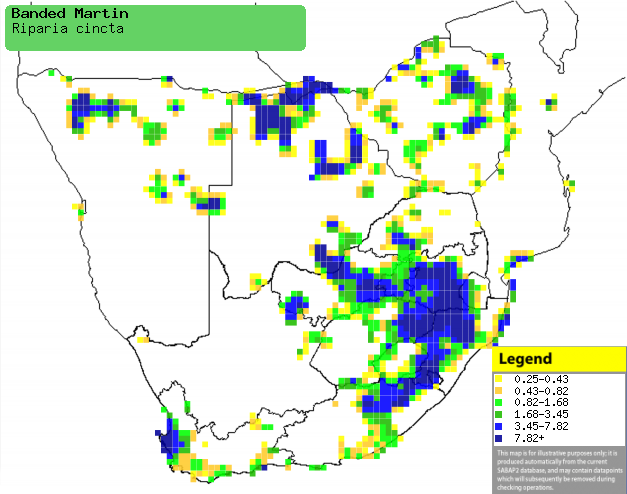|
Riparia cincta (Banded martin)
Gebande oewerswael [Afrikaans]; Sisampamema (generic term
for swallows, martins, swifts and spinetails) [Kwangali]; Lekabelane (generic
term for swallows or martins) [South Sotho]; Nyenganyenga (generic name for
swallow or martin) [Shona]; Mbawulwana, Nyenga (generic term for swallow)
[Tsonga]; Pêolwane, Phêtla (generic terms for swifts, martins and swallows)
[Tswana]; bandoeverzwaluw, witbrauwzwaluw [Dutch]; Hirondelle à collier
[French]; Bindenschwalbe, Weißbrauenschwalbe, Gebänderte uferschwalbe
[German]; Andorinha-das-barreiras-de-colar [Portuguese]
Life
> Eukaryotes >
Opisthokonta
> Metazoa (animals) >
Bilateria >
Deuterostomia > Chordata >
Craniata > Vertebrata (vertebrates) > Gnathostomata (jawed
vertebrates) > Teleostomi (teleost fish) > Osteichthyes (bony fish) > Class:
Sarcopterygii (lobe-finned
fish) > Stegocephalia (terrestrial
vertebrates) > Tetrapoda
(four-legged vertebrates) > Reptiliomorpha > Amniota >
Reptilia (reptiles) >
Romeriida > Diapsida > Archosauromorpha > Archosauria >
Dinosauria
(dinosaurs) > Saurischia > Theropoda (bipedal predatory dinosaurs) >
Coelurosauria > Maniraptora > Aves
(birds) >
Order: Passeriformes > Family: Hirundinidae
Distribution and habitat
Patchy across sub-Saharan Africa, with isolated populations
in West and East Africa but with a large proportion south of the equator,
from southern DRC to southern Africa. Here it occurs across much of the eastern
half of South Africa extending into the Western Cape around Cape Town. It also
occupies scattered areas of northern Namibia (including the Caprivi Strip, where
it is common), northern, eastern and southern Botswana, Zimbabwe and the extreme
south of Mozambique. It generally prefers dry grassland, shrubland, marshes
(especially in the Okavango Delta) and pastures. It is rarely observed over
rocky shorelines or along the borders of estuaries.
|
 |
|
Distribution of Banded martin in southern Africa,
based on statistical smoothing of the records from first SA Bird Atlas
Project (©
Animal Demography unit, University of
Cape Town; smoothing by Birgit Erni and Francesca Little). Colours range
from dark blue (most common) through to yellow (least common).
See here for the latest distribution
from the SABAP2. |
Brood parasites
It has been recorded as host of the
Greater honeyguide.
Movements and migrations
Intra-African breeding migrant, arriving in
South Africa and Zimbabwe around September-October, later in central
Namibia. It departs around April-May for its non-breeding grounds,
which are probably in equatorial Africa. However, it is resident in
southern Mozambique as well as northern Botswana and the Caprivi
Strip.
Food
It mainly eats flying insects, usually foraging by flying
slowly near the ground, often hawking prey disturbed by bushfires, zebras,
antelope or cattle.
Breeding
- The nest is a structure made of feathers and grass, placed in a chamber
connected to a upward-sloping tunnel. It is usually dug into a stream bank,
erosion gully or sand pit.
- Egg-laying season is from August-March, peaking from November-February.
- It lays 2-4 glossy white eggs.
- In one observation the chicks are fed by both adults, leaving the nest
after about 21-24 days. The following food items were recorded in their
diet:
Threats
Not threatened, in fact has benefited from the clearing of
woodland for agricultural development.
References
-
Hockey PAR, Dean WRJ and Ryan PG 2005. Roberts
- Birds of southern Africa, VIIth ed. The Trustees of the John Voelcker
Bird Book Fund, Cape Town.
-
Harrison, J.A., Allan, D.G., Underhill, L.G., Herremans, M.,
Tree. A.J., Parker, V. & Brown, C.J. (eds). 1997. The atlas of southern
African birds. Vol. 2: Passerines. BirdLife South Africa, Johannesburg.
|
